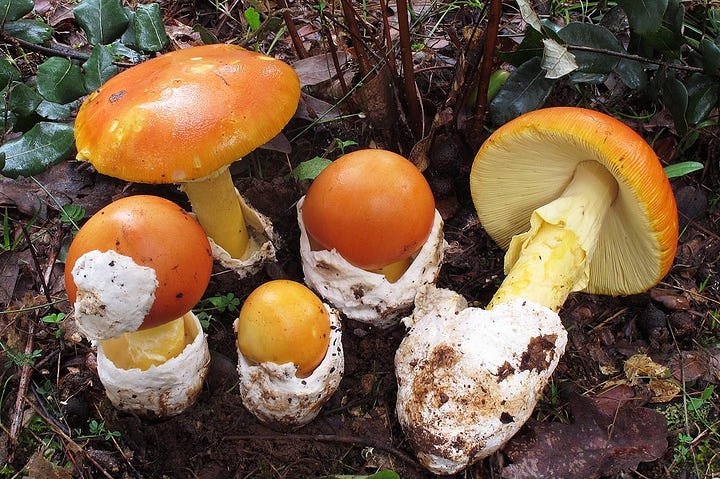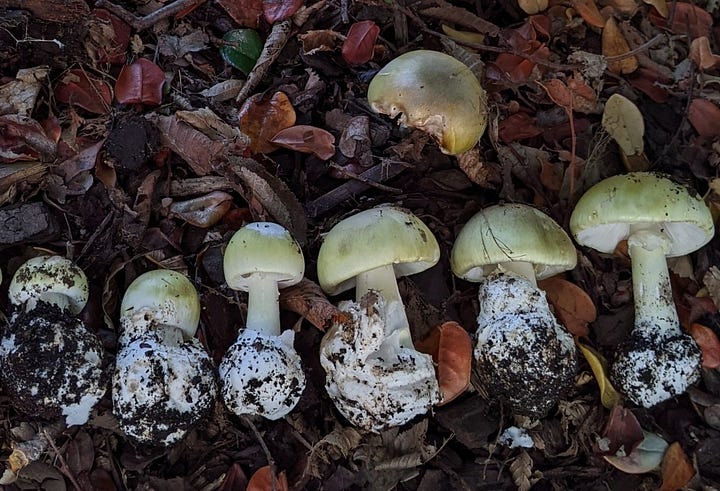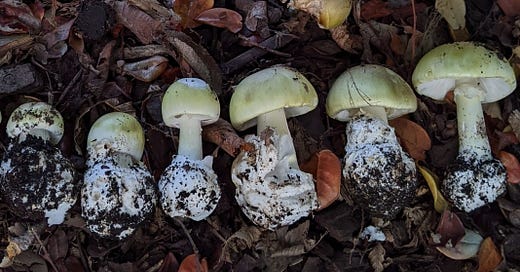Imperial intrigue
Were death caps involved in a 2000 year old true crime mystery? (3 minute preview, 7 minute read)
I can’t remember where or when I bought my tatty old copy of Robert Graves’s I Claudius, but it’s been on my bookshelf for years, and I’ve read it several times. It’s a classic of historical fiction, a first person retelling of the story of Rome’s first imperial dynasty. Claudius, the narrator, is a clever man who allows people to think he’s a fool, enabling him to observe the drama and intrigue without becoming embroiled in it. At the end of the novel, with the assassination of his nephew Caligula, Claudius becomes the emperor.
I didn’t intend to write about Claudius this week, but I uncovered some curious amanita-related facts while researching his grandmother, Livia. Her villa contained what we now consider to be one of the masterpieces of Roman art, an entire room painted as a garden. I wanted to write about the painting and the plants in it, but I became distracted by scholarly debates about whether Claudius was poisoned by death caps1.
Scholars ancient and modern have offered opinions on Claudius’s cause of death. The majority of ancient scholars state that his fourth wife, Agrippina the younger, poisoned him with a dish of mushrooms. A fairly common modern version of the story has him dining on his favourite mushrooms, a kind of amanita known as Caesar’s mushroom2. In this version, Agrippina adds extracts of another amanita, the death cap, to the dish.


This claim is often uncritically repeated. It makes a good story, but is any of it true? A closer examination suggests that the facts are far from clear.
Claudius was one of the emperors known as Caesar, as he was part of the dynasty established by the Emperor Augustus, who took the name Caesar when he was adopted by Julius Caesar. It’s generally undisputed that Caesar’s mushrooms were named because Claudius and his uncle, the Emperor Tiberius, were known to be particularly fond of them. Beyond that, though, there’s little agreement.
Those who support the death cap theory, suggest tat Agrippina sought a slow poison, so that Claudius couldn’t know who had poisoned him. As I wrote in Friday’s article, the symptoms of death cap poisoning take at least 6 hours to develop, usually 8-12 hours. Those who suffer a fatal illness typically die from liver failure a week or more after eating the mushrooms. If Agrippina sought a slow poison, then death cap would appear to be a prime candidate. The proponents of death caps quote Seneca, a contemporary of Claudius. Seneca notes that poisoning by mushrooms doesn’t show immediate symptoms, suggesting that the course of death cap poisoning was known at the time.
The sources who suggest Agrippina sought a slow poison are two famous Roman writers, Suetonius and Tacitus. Both authors state that Agrippina added poison to the mushroom dish, but their statements are questionable on this subject. They were writing many decades after the events they recount and scholars debate their accuracy. Suetonius is described as free with scandalous gossip. His biographies of the early emperors, Claudius included, are salacious but not necessarily accurate. Tacitus was writing a critique of dyanstic power, so was painting the emperors, and particularly their wives, in as poor a light as possible. I have to question, therefore, whether what they say about Agrippina is true.
Some authors have looked at Claudius’s symptoms and noted that these were inconsistent with death caps. They quote sources which suggest that Claudius sickened and died rapidly after supposedly eating poisonous mushrooms. As an alternative, they suggest a different kind of toxic mushroom was involved. They note that some of the symptoms are more consistent with muscarine poisoning, and that, combined with Claudius’s pre-existing medical conditions, could have caused the reported symptoms and rapid death. A number of mushrooms contain dangerous quantities of muscarine, but the authors don’t provide any evidence that these were known to the ancient Romans.




